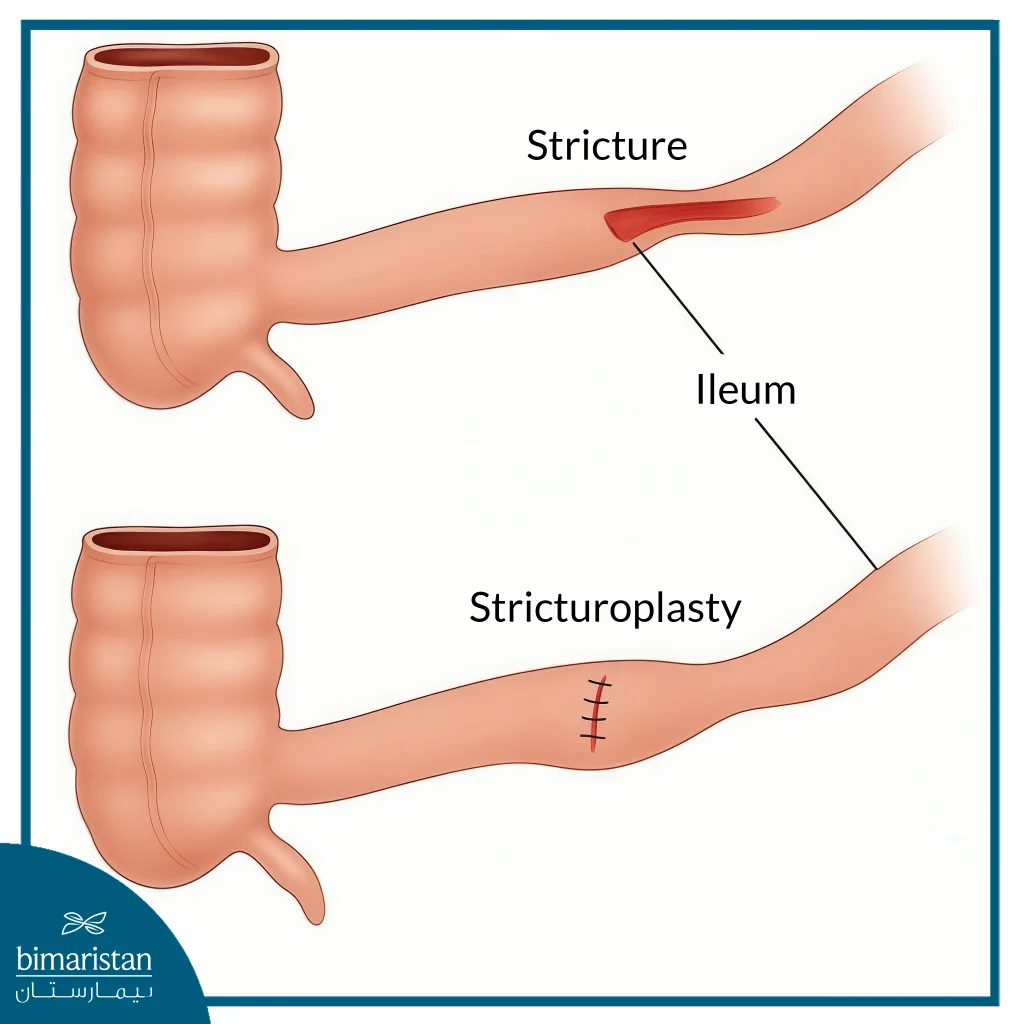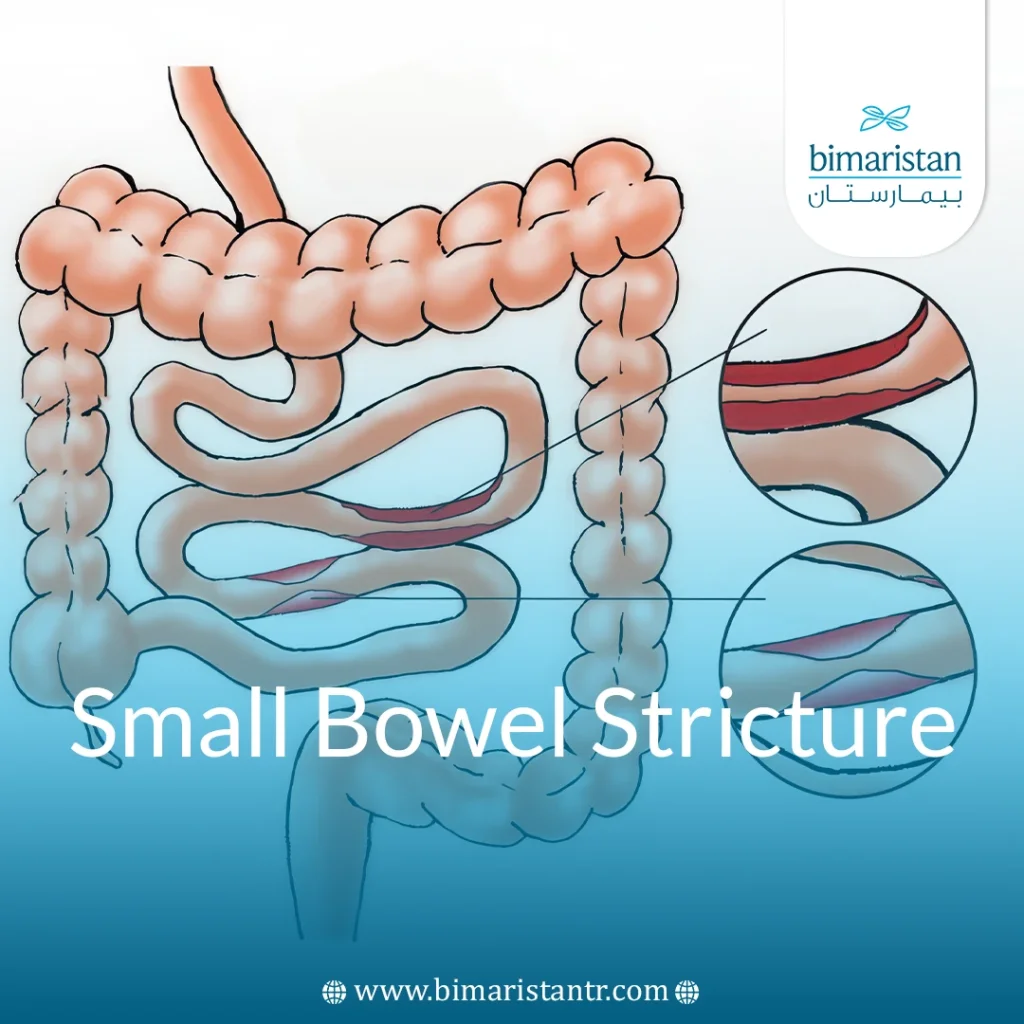The small intestine is an essential part of the digestive system, responsible for the digestion and absorption of most nutrients. Small bowel stricture can lead to serious digestive issues such as obstruction and malabsorption if not treated appropriately, so early detection and identification of the cause of the stenosis are important to choose the right treatment.
What is a small bowel stricture?
Small bowel stricture is an abnormal constriction or narrowing of a part of the small intestine that obstructs the passage of food and fluids. It is a common complication in people with Crohn’s disease, and may also occur due to other causes such as medications or surgery:
- Partial: Allows food to pass with digestive symptoms such as bloating and cramping.
- Full: Causes a complete blockage and can lead to serious complications.
This stricture impairs digestion and nutrient absorption, leading to malnutrition, weight loss, and vitamin deficiencies. The condition requires careful evaluation to determine its nature and choose the appropriate treatment, whether pharmaceutical, endoscopic, or surgical.

What causes small bowel stricture?
Common causes of small bowel stricture:
- Crohn’s disease: One of the most common causes, it causes chronic inflammation that leads to fibrosis and narrowing of the intestines.
- Chronic intestinal inflammation: Like ulcerative colitis, it may cause strictures as a result of ongoing inflammation.
- Intestinal adhesions: Often occur after surgery due to fibrosis of the tissue, leading to narrowing or obstruction.
- Tumors (benign or malignant): They can squeeze or grow inside the intestines, causing narrowing.
Less common or atypical causes:
- Radiation therapy: Causes damage and fibrosis to the intestines over time, leading to narrowing in the affected areas.
- Nonsteroidal anti-inflammatory drugs (NSAIDs): Chronic use can lead to thin constrictions known as “diaphragmatic constrictions.”
- Ischemia: Poor blood flow causes tissue damage and fibrosis, leading to narrowing of the small intestine
- Congenital defects: Congenital narrowing or blockages are often seen in newborns.
- Inflammation of the blood vessels: Diseases such as lupus damage the walls of the blood vessels that feed the intestines, causing narrowing.
- Idiopathic causes: In some cases, no clear cause of intestinal strictures can be identified.
- Postoperative strictures: They appear at the sites of surgical interventions as a result of scarring or abnormal healing.
- Behçet’s disease: Causes chronic ulceration that may lead to fibrosis and narrowing of the small intestine.
Symptoms of small bowel stricture
Mild to moderate symptoms
Mild to moderate symptoms are signs of partial stenosis or the beginning of obstruction, where the obstruction is not yet complete, and the bowel is still trying to deal with the issue:
- Abdominal cramps: You feel them as your intestines try to overcome the narrowing.
- Abdominal pain: Varies from mild to severe depending on the severity of the stenosis.
- Bloating, Gas buildup due to obstruction of the bowel passage.
- Loss of appetite, the result of constant discomfort and pain.
- Overwork: May result from malabsorption or loss of appetite.
Severe symptoms
Severe symptoms are caused by a complete and serious blockage, including the following:
- Severe abdominal pain: A sign of a complete blockage or serious complications.
- Nausea: Due to the buildup of intestinal contents and its effect on the digestive system.
- Vomiting: A symptom of severe blockage where food cannot pass.
- Constipation: Due to the inability of the intestines to pass waste.
- Bloating and stretching in the abdomen: A sign of a complete or near-complete blockage.
How is small bowel stricture diagnosed?
- Clinical examination and history of symptoms: Helps in recognizing the pattern of symptoms such as pain, bloating, and change in bowel movements, and determining the severity and duration of symptoms.
- Blood tests: They show indirect indicators such as anemia, inflammation (CRP, ESR), or malabsorption, but do not directly detect stenosis.
- Radiography with contrast material (Small Bowel Follow-Through): Shows strictures and slower passage of barium through the small intestine.
- Computed tomography (CT Enterography): Provides precise images to determine the location and severity of the stenosis and detects inflammation or associated complications.
- Magnetic resonance enterography (MR Enterography): Evaluates the stricture and surrounding tissue without the use of radiation and differentiates between inflammatory and fibrotic strictures.
- Capsule Endoscopy: It accurately shows the inside surface of the intestine, but can get stuck at sites of stricture, so it is used with caution.
- Double Balloon Enteroscopy: Provides direct visualization of the stricture with the possibility of treatment such as dilation or biopsy in the same session.
Treatment options for small bowel stricture
Conservative treatment (in mild cases or the absence of complications)
- Bowel rest: Reducing or stopping oral intake of food to minimize pressure on the intestines.
- Intravenous nutrition (TPN): Providing the body with nutrients through a vein if you are unable to take food orally.
- Observation and follow-up: Assessing the progression of symptoms and the patient’s response to treatment without direct intervention.
Laparoscopic treatment (for short and simple stenoses)
- Endoscopic Balloon Dilation (EBD): It is a non-surgical procedure used to treat small bowel stricture by inserting a balloon through the endoscope and inflating the balloon to expand the stenosis. It is an effective option to postpone surgery, especially in Crohn’s disease, and is characterized by fast recovery, low risk, and can be repeated as needed.
Surgery (for advanced cases or complex stenoses)
- Resection: Removing the entire affected part of the intestine if other treatments have failed or there are complications.
- Anastomosis: The reattachment of the two ends of the intestine after resection to ensure continuity of the digestive tract.
- Bypass surgery: Diverting food away from the narrowed area without removing it, sometimes used to minimize risk in complex cases.
Can the stenosis come back after treatment?
Yes, bowel stenosis can return after treatment, especially in cases of chronic diseases such as Crohn’s disease, as this disease is a recurrent inflammatory condition that may lead to new stenoses even after balloon dilation or surgical resection, so it is important to adhere to regular medical follow-up for early detection of any relapse, and controlling inflammation through appropriate treatment helps reduce the likelihood of recurrence.
Possible complications if treatment is neglected
- Intestinal obstruction: Intestinal narrowing can cause a complete blockage that prevents the passage of waste, leading to severe pain, nausea, vomiting, and bloating.
- Intestinal rupture: The weakening of the intestinal wall caused by the stenosis may cause the intestine to rupture and leak its contents into the abdominal cavity, causing peritonitis and serious infection.
- Acute malnutrition: Chronic bowel obstruction affects the absorption of food, leading to malnutrition.
- Dehydration and electrical imbalances: Frequent vomiting and fluid loss cause dehydration and electrolyte imbalances.
Tips for prevention and follow-up
- Regular medical follow-up
- Eat a healthy and balanced diet
- Pay attention to recurring digestive symptoms
- Control of chronic causative diseases such as Crohn’s disease
- Temporarily modify your diet: Eat small meals, cook food thoroughly, and avoid tough meats, nuts, seeds, fruit and vegetable peels, mushrooms, and beans.
- Consult your doctor before any dietary changes to avoid vitamin and mineral deficiencies.
In conclusion, small bowel stricture is a condition that can be successfully treated with early diagnosis and appropriate intervention. Adherence to treatment and follow-up can improve outcomes and prevent complications of small bowel stricture.
Sources:
- UpToDate. (2024). Small bowel strictures: Diagnosis and management.
- National Institute of Diabetes and Digestive and Kidney Diseases (NIDDK). (2023). Intestinal strictures and blockages.

